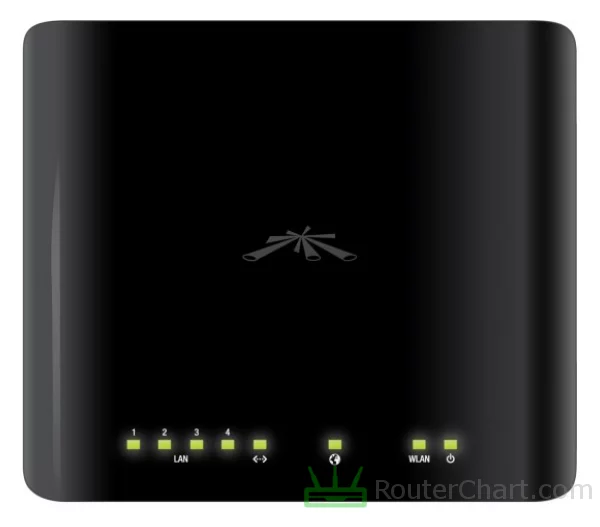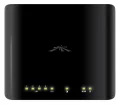Ubiquiti airRouter WiFi: Pros and Cons
The Ubiquiti airRouter (AR) router released in 2010. It is powered by Atheros AR7241 @ 400 MHz chipset, 32 MB of RAM and 8 MB of flash. The N150 router is compatible with IEEE 802.11b/g/n standards, and the maximum speed that you can get with airRouter is 150 Mbps. The router has 1 x 10/100 Mbps WAN and 4 x 10/100 Mbps LAN ports.
Table of Contents
Our personal experiences and opinions form the basis of this article. We aimed to share insights on a topic, and we hoped others would find it useful and inspirational. The specs below rely on official manufacturer data, but we also consider user reviews. If you noticed any mistakes or missing details about the Ubiquiti airRouter, please let us know. Furthermore, we strive to deliver a thorough and precise overview.

This router is basic 2.4 GHz router. It provides reliable for small networks. The USB connectors on the router add versatility to your network. They enable file sharing, printer sharing, and other USB functions. Ubiquiti has established a solid reputation as a reliable and reputable networking brand.
Ubiquiti airRouter specifications
| Brand | Ubiquiti |
|---|---|
| Name | airRouter |
| Type | AR |
| Rating | |
| Launch | 2010 |
Body
| Dimensions | 162 x 132 x 30 mm |
|---|---|
| Weight | 221 g |
If you have limited space, like in a small apartment or office, the dimensions can determine if it can fit there. If you purchase a router online or have it shipped, the weight may affect the overall cost.
System
| Chipset | Atheros AR7241 @ 400 MHz |
|---|---|
| RAM | 32 MB |
| Flash | 8 MB |
| OS | Ubiquiti |
| Power supply | 5 V / 2 A |
The Atheros AR7241 @ 400 MHz CPU is key. It, along with factors like RAM and firmware, decides how well the router works. Some router features and software need a certain amount of RAM. They need it to work well. More storage space comes from a larger flash memory. It can accommodate future firmware upgrades. Upgrading router firmware has become simple and user-friendly. The Ubiquiti provides the right power supply. It is 5 V / 2 A, this matches the router's voltage needs.
Network
| Protocols | IPv4 |
|---|---|
| LAN ports | 4 x 10/100 Mbps |
| WAN ports | 1 x 10/100 Mbps |
| Mobile network | no |
| VPN support | no |
The airRouter router has built-in security features. They protect your network and devices. Most networking equipment, like routers and switches, supports IPv4. Wired connections may bottleneck due to the limits of Fast Ethernet ports.

Wireless
| Antennas | 2 x 0 dBi internal |
|---|---|
| 2.4 GHz | yes |
| 5 GHz | no |
| 60 GHz | no |
| Standards | IEEE 802.11b/g/n |
| Class | N150 |
| Speed | 150 Mbps |
| Transmit power | 19 dBm |
| Security | WEP WPA WPA2 |
| Guest network | no |
The 2 x 0 dBi, internal antennas allow sending and getting many data streams at once. This boosts overall throughput and improves Wi-Fi performance. The router supports the 2.4 GHz Wi-Fi. Older routers have a more limited range than newer Wi-Fi standards. So, they are less suitable for larger homes or offices. Real-world airRouter router speeds are lower than its theoretical maximum speed. WEP was the first Wi-Fi security protocol. But it is now seen as weak and easy to hack. The introduction of WPA2 (Wi-Fi Protected Access 2) improved upon WEP. It provides stronger security.
Connectivity
| USB ports | 1 x USB 2.0 |
|---|---|
| Print server | yes |
| File server | yes |
The USB 2 port has a maximum theoretical data transfer rate of 480 megabits per second (Mbps). A USB print server adds print functionality. You can manage settings, watch queues, and control access from one place. The airRouter router lets you schedule backups. You can back up to the connected USB storage device.
Administration
| Default IP | 192.168.1.1 |
|---|---|
| Default username | ubnt |
| Default password | ubnt |
If you can't log in to your Ubiquiti router's setup panel, try resetting it. A reset can help you troubleshoot. It is highly recommended to change the default password of your airRouter router. Do this after the initial setup.
Pros and Cons
Every router, including this Ubiquiti one, has its good sides and not-so-good sides. Let's take a closer look at both to get a full understanding of what this router can do. We'll talk about what it does well and also where it could use some improvements. Just remember, this is just what I think, and you might see things differently.
Pros
- lightweight
- USB 2 compatible
- printserver functionality
- fileserver operation
Cons
- insufficient flash
- lack of Gigabit LAN
- Non-gigabit WAN port
- missing Wi-Fi 6 support
- lacks Wi-Fi 5 compatibility
- reduced Wi-Fi bandwidth
- incompatible with WPA3
- missing WPS support
Ubiquiti airRouter photos


If there’s information about the Ubiquiti airRouter that you would like to see on this site, then write to us.

